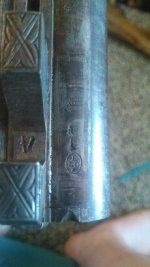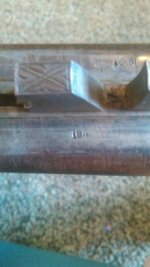You are using an out of date browser. It may not display this or other websites correctly.
You should upgrade or use an alternative browser.
You should upgrade or use an alternative browser.
help with proof marks
- Thread starter Outdated guns
- Start date
I don't know shotguns but check www.damascus-barrels.com, under free extras. some proof mark info there. Hope that will help some.
The single oval is the marking for a muzzle loading gun proved with a standard load (black powder) rather than a proof load. This was done with very light guns that could be damaged beyond repair by firing with a regular proof load. The "perron" mark is used on guns that passed black powder proof.
The "R" in that position is probably an inspector's initial (with an asterisk) but could also indicate (with a crown) proof of a rifled barrel. The "L" is the mark for voluntary proof of an unfinished barrel. That would be consistent with the standard load proof of a light gun. (They had the unfinished barrel proved to keep from the expense of finishing a barrel that might well blow.)
Jim
The "R" in that position is probably an inspector's initial (with an asterisk) but could also indicate (with a crown) proof of a rifled barrel. The "L" is the mark for voluntary proof of an unfinished barrel. That would be consistent with the standard load proof of a light gun. (They had the unfinished barrel proved to keep from the expense of finishing a barrel that might well blow.)
Jim
mapsjanhere
New member
There are several lists out trying to date Belgian inspector marks, but they're not very reliable, often spanning several decades. Laminated barrels and black powder only proof dates your gun to 1880 ± 20 years.
The 'E' over the 'LG' is a British and Belgian BP rifle proof mark used from 1811-1892. Said to be put on handguns after 1924 and on barrels exported that were not finished.
Until W.W. I, there were hundreds of shops building stuff around Liege for British sellers.
I think the '18' and whatever else is with it(too small) is about the choke. Also seen as the bore diameter in millimeters from 1810 to 1893.
http://www.nramuseum.com/media/940944/proofmarks.pdf
"laminated steel barrels" equals Damascus. Not considered safe to shoot with any ammo. Despite what you seen on the internet.
Until W.W. I, there were hundreds of shops building stuff around Liege for British sellers.
I think the '18' and whatever else is with it(too small) is about the choke. Also seen as the bore diameter in millimeters from 1810 to 1893.
http://www.nramuseum.com/media/940944/proofmarks.pdf
"laminated steel barrels" equals Damascus. Not considered safe to shoot with any ammo. Despite what you seen on the internet.
The Liege proof mark "E L G" in an oval is not British and never was. The confusion arose when someone posted an erroneous picture of a page showing Belgian proofs, but with a page break error making it look like they were British.
The Liege proof rules are too lengthy to be quoted here, plus there seem to be errors and contradictions in all lists, even the official ones put out by the Belgian government.
Jim
The Liege proof rules are too lengthy to be quoted here, plus there seem to be errors and contradictions in all lists, even the official ones put out by the Belgian government.
Jim


